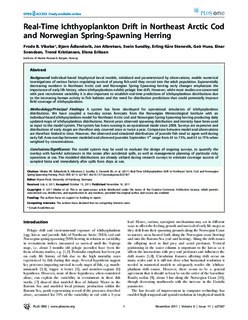| dc.description.abstract | Background: Individual-based biophysical larval models, initialized and parameterized by observations, enable numerical
investigations of various factors regulating survival of young fish until they recruit into the adult population. Exponentially
decreasing numbers in Northeast Arctic cod and Norwegian Spring Spawning herring early changes emphasizes the
importance of early life history, when ichthyoplankton exhibit pelagic free drift. However, while most studies are concerned
with past recruitment variability it is also important to establish real-time predictions of ichthyoplankton distributions due
to the increasing human activity in fish habitats and the need for distribution predictions that could potentially improve
field coverage of ichthyoplankton.
Methodology/Principal Findings: A system has been developed for operational simulation of ichthyoplankton
distributions. We have coupled a two-day ocean forecasts from the Norwegian Meteorological Institute with an
individual-based ichthyoplankton model for Northeast Arctic cod and Norwegian Spring Spawning herring producing daily
updated maps of ichthyoplankton distributions. Recent years observed spawning distribution and intensity have been used
as input to the model system. The system has been running in an operational mode since 2008. Surveys are expensive and
distributions of early stages are therefore only covered once or twice a year. Comparison between model and observations
are therefore limited in time. However, the observed and simulated distributions of juvenile fish tend to agree well during
early fall. Area-overlap between modeled and observed juveniles September 1st range from 61 to 73%, and 61 to 71% when
weighted by concentrations.
Conclusions/Significance: The model system may be used to evaluate the design of ongoing surveys, to quantify the
overlap with harmful substances in the ocean after accidental spills, as well as management planning of particular risky
operations at sea. The modeled distributions are already utilized during research surveys to estimate coverage success of
sampled biota and immediately after spills from ships at sea. | no_NO |
